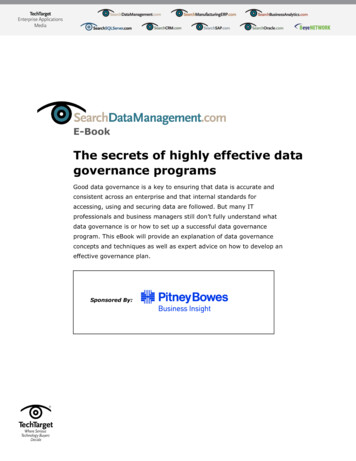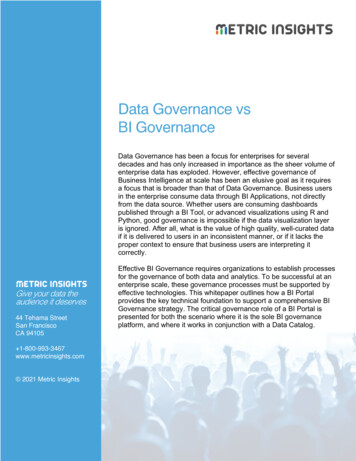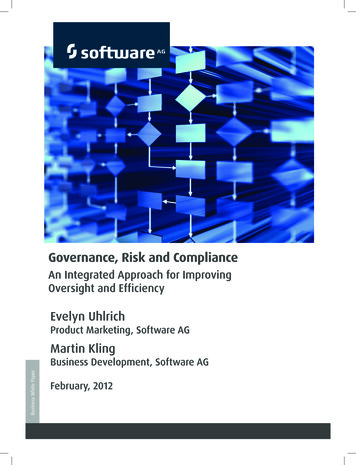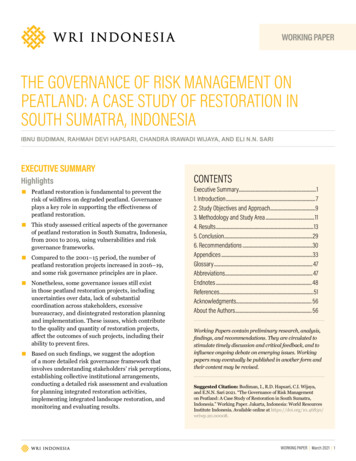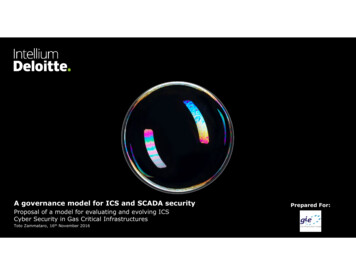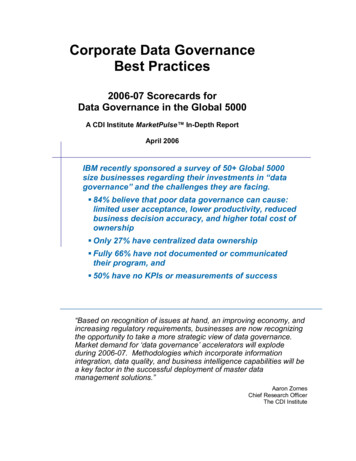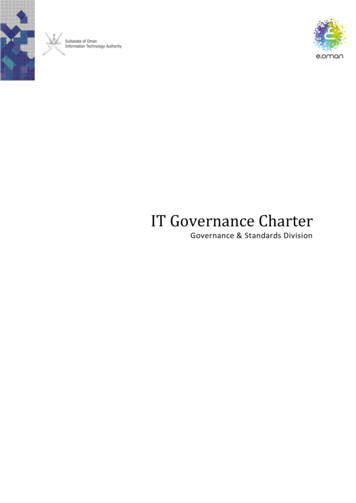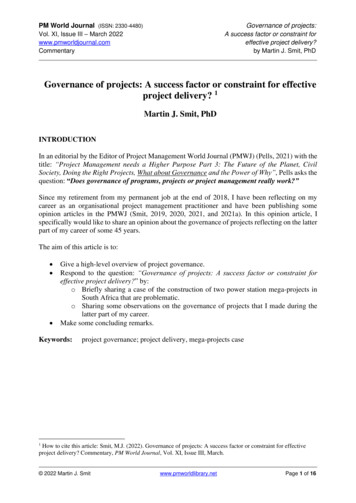
Transcription
PM World Journal (ISSN: 2330-4480)Vol. XI, Issue III – March 2022www.pmworldjournal.comCommentaryGovernance of projects:A success factor or constraint foreffective project delivery?by Martin J. Smit, PhDGovernance of projects: A success factor or constraint for effectiveproject delivery? 1Martin J. Smit, PhDINTRODUCTIONIn an editorial by the Editor of Project Management World Journal (PMWJ) (Pells, 2021) with thetitle: “Project Management needs a Higher Purpose Part 3: The Future of the Planet, CivilSociety, Doing the Right Projects, What about Governance and the Power of Why”, Pells asks thequestion: “Does governance of programs, projects or project management really work?”Since my retirement from my permanent job at the end of 2018, I have been reflecting on mycareer as an organisational project management practitioner and have been publishing someopinion articles in the PMWJ (Smit, 2019, 2020, 2021, and 2021a). In this opinion article, Ispecifically would like to share an opinion about the governance of projects reflecting on the latterpart of my career of some 45 years.The aim of this article is to: Give a high-level overview of project governance.Respond to the question: “Governance of projects: A success factor or constraint foreffective project delivery?” by:o Briefly sharing a case of the construction of two power station mega-projects inSouth Africa that are problematic.o Sharing some observations on the governance of projects that I made during thelatter part of my career.Make some concluding remarks.Keywords:project governance; project delivery, mega-projects case1How to cite this article: Smit, M.J. (2022). Governance of projects: A success factor or constraint for effectiveproject delivery? Commentary, PM World Journal, Vol. XI, Issue III, March. 2022 Martin J. Smitwww.pmworldlibrary.netPage 1 of 16
PM World Journal (ISSN: 2330-4480)Vol. XI, Issue III – March 2022www.pmworldjournal.comCommentaryGovernance of projects:A success factor or constraint foreffective project delivery?by Martin J. Smit, PhDHIGH-LEVEL OVERVIEW OF PROJECT GOVERNANCEThe high-level overview of project governance in this section is mainly based on a literaturereview I did on project governance in 2015 as part of my PhD thesis, as well as a featured paperby myself (Smit, 2017) with the title: “Development of a project portfolio management model forexecuting organizational strategies” that was published in PMWJ (please see the Refences in thispaper from which the content of this high-level overview was derived). The high-level overviewalso includes some key points about the governance of mega-projects as discussed in a podcast byFlyvbjerk during a Better Boards Podcast Series (2020).Definition of corporate governanceA definition for corporate governance according to the Organization for Economic Co-operationand Development (OECD) Principles of Corporate Governance is:“Corporate governance involves a set of relationships between a company’s management, itsboard, its shareholders and other stakeholders. Corporate governance also provides thestructure through which the objectives of the company are set, and the means of attaining thoseobjectives and monitoring performance are determined.”Differences between the functions of governance and managementThere is often confusion about the difference between the functions of governance andmanagement. The five functions of management are to: Forecast and plan.Organize.Command or direct (lead).Coordinate.Control.Good governance is achieved by integrating, coordinating, and balancing the following sixfunctions: Determining the objectives of the organization.Determining the ethics of the organization.Creating the culture of the organization.Designing and implementing the governance framework for the organization.Ensuring accountability by management.Ensuring compliance by the organization.Implementation of a governance frameworkThe implementation of a governance framework in an organization consists of five main themes: 2022 Martin J. Smitwww.pmworldlibrary.netPage 2 of 16
PM World Journal (ISSN: 2330-4480)Vol. XI, Issue III – March 2022www.pmworldjournal.comCommentary Governance of projects:A success factor or constraint foreffective project delivery?by Martin J. Smit, PhDGoverning relationships.Governing change.Governing the organization’s people.Financial governance.Viability and sustainability.The role of strategic planningThe strategic plan is a key interface between the governing body and the management with sharedresponsibility to develop an effective strategy for management to implement. The governing bodyappoints management, provides direction to, and oversees the functioning of the organization’smanagement, and makes the rules the organization’s management and staff are expected toconform to. Management’s job is to achieve the objectives of the organization, working withinits ethical and cultural framework whilst complying with the rules and providing assurance backto the governing body that this is being accomplished. Strategic planning sets the context withinwhich portfolio management operates.Governance of portfolios, programs, and projectsThe governance of portfolios, programs and projects is an integral part of the governing changetheme. Portfolio governance is established by a governing body to make decisions aboutinvestments and priorities for the portfolio and ensures that portfolio management processes arefollowed to sustain the organization. The effectiveness of governance is based on how well theorganization enforces current standards, policies, and processes; and how well the organizationimplements change. Effective governance must promote and support a culture of value, such thatthe organization has a shared understanding what constitutes value for the organization, clearlydefined roles, responsibilities and accountabilities, processes, and practices around valuemanagement, with active benefits and change management, and relevant metrics.Why is effective governance and management important?Governance, when well-understood, carefully planned, and thoughtfully executed, can be one ofthe most crucial drivers of growth. In many situations, particularly associated with the governanceof programs and projects, the governing of organizations is far from effective. The number ofresources wasted by ineffective and competing management groups can be significantly reducedif the organization’s objectives, ethics, and culture are sound. Strong governance is thus neededto make portfolio management work.Executive management is responsible for creating an organization capable of achieving theobjectives defined by the governance system. They also have responsibility for providingassurances to the governance system that resources of all types are being effectively and ethicallyused. 2022 Martin J. Smitwww.pmworldlibrary.netPage 3 of 16
PM World Journal (ISSN: 2330-4480)Vol. XI, Issue III – March 2022www.pmworldjournal.comCommentaryGovernance of projects:A success factor or constraint foreffective project delivery?by Martin J. Smit, PhDElements of the project delivery system that supports governanceThe project delivery system has the capability to deliver programs and projects successfully,including the portfolio management sub-system, and the organizational change sub-system. Fourinterrelated elements are required to support governance of programs and projects. These elementsare: Portfolio management.Program/project sponsors.Strategic and/or Enterprise Project Management Office (EPMO).Effective program and project management.Portfolio management focuses on selecting the right programs and projects to start or maintain,and which to defer or cancel. Portfolio management supports the overall governance processes bybalancing the workload against the organization’s capability and capacity to undertake the workand ensures an appropriate mix of high-risk, high-return programs and projects. The portfoliomanagement function gathers and validates the capability and resource availability; applies thepolicies, procedures, methods, and criteria to make and implement effective decisions; andcontinuously review, learn, and improve portfolio management.The program/project sponsor is a critical link between the executive and strategic levels to ensurethat business benefits are identified and realized and provides support to program and projectmanagers, and the project teams to fulfil their roles effectively.The contribution of the Strategic and/or EPMO ranges from providing internal consulting services,organizational project management knowledge, and application of a clear set of project processperformance standards for portfolio, program and project work; monitoring and controlling ofprogram and project performance; and ensuring that accurate interpretive and predictiveassessment information is available to senior and executive management to support the portfoliomanagement decision-making process.Effective program and project management require that project managers create the outputs anddeliverables as efficiently as possible, while working ethically and in accord with theorganization’s practices and procedures to achieve the organization’s strategic and tacticalobjectives.Project governance must ensure that: An appropriate project organization is in place to undertake projects.Decision-makers at each level are accountable to higher-level management for keydecisions.The application of any organizational constraints, such as standards and components tobe used are supported by an appropriate assurance system. 2022 Martin J. Smitwww.pmworldlibrary.netPage 4 of 16
PM World Journal (ISSN: 2330-4480)Vol. XI, Issue III – March 2022www.pmworldjournal.comCommentaryGovernance of projects:A success factor or constraint foreffective project delivery?by Martin J. Smit, PhDGovernance of mega-projectsDuring a Better Boards Podcast Series in a podcast by Flyvbjerg (2020) about mega-projects,Flyvbjerk made the following important comments: It is important for boards not to delegate mega-projects. Mega-projects are too big,complex, expensive, impactful, and consequential for an organisation and therefor boardscannot leave them out of sight. Mega-projects need special oversight and therefore theyshould not be delegated to the CEO who further delegates these projects down in theorganisation. One mega-project going wrong can destroy the organisation. A board’s firstresponsibility is towards the interest of the organisation and thereafter the shareholdersand other stakeholders.A culture that encourages the reporting of bad news quickly should be cultivated.Mega-projects are complex and therefore there will be bad news. The sooner bad news isreported, the sooner it can be dealt with and the better it will be for the organisation. Peoplereporting bad news about what is going on should be welcomed (do not kill the messenger).Boards should not be isolated from bad news and therefor need an early warning systemand incentive structure to reward the early reporting of bad news. Early delays and costoverruns need to be escalated quickly. If these are hidden and not given the requiredattention, mega-projects can lead to disasters.Flyvbjerk (2020) highlighted three points that will result in the unsuccessful delivery of megaprojects: A bad business case that is not implementable will fail, as well as a bad business plan. Amega-project needs a detailed business plan and proper front-end planning before startingwith project delivery. Mega-projects should not be implemented early unless proper frontend planning has been done.Not having the right people/team with the required experience in place to deliver theproject.A governance structure that is not right for the project to get the right outcome.Summary and conclusionGovernance, when well-understood, carefully planned, and thoughtfully executed, can be one ofthe most crucial drivers of growth. The following contribute to effective project governance in anorganization: Clear and continued communication of organizational goals and objectives within aframework of sound organizational ethics and culture. Good collaboration between governance boards, executive management, strategicmanagement, portfolio management, program and project management, and operations toensure that the right programs and projects are selected that will deliver the most optimumsustainable business value. This also includes which programs or projects must be deferredor canceled. 2022 Martin J. Smitwww.pmworldlibrary.netPage 5 of 16
PM World Journal (ISSN: 2330-4480)Vol. XI, Issue III – March 2022www.pmworldjournal.comCommentaryGovernance of projects:A success factor or constraint foreffective project delivery?by Martin J. Smit, PhD Enforcement and application of appropriate portfolio-, program-, and projectmanagement methodologies/approaches, organizational policies, standards, procedures,processes, etc. to ensure that change is implemented well. Promotion and support of a culture of value where:o All stakeholders behave in an ethical and respectful manner.o Roles, responsibilities and accountabilities, processes, and practices around valuemanagement are clearly defined with active benefits and change management, andrelevant metrics.o The reporting of bad news is encouraged, and quick and decisive action is taken.The following project governance issues negatively impact effective project delivery:Mega-projects Boards that delegate mega-projects to the CEO, and the CEO who further delegate theseprojects down in the organization, without proper direction and adequate oversight by theboard.Starting with the execution of mega-projects without a detailed business plan and/or properfront-end planning.Programs and projects Business cases that are not accurate and/or implementable and/or do not support theorganizational goals and objectives.Insufficient resource planning and/or not having adequate resource capacity and capabilityto deliver all the approved programs and projects.Different divisions/departments/management groups competing for limited finances andresources could lead to resources not being effectively and ethically used.Governance structures that are not right for the specific programs and projects to achievethe right outcomes.Inexperienced program and project sponsors not fulfilling their roles as the critical linkbetween the executive and strategic levels to ensure that business benefits are identifiedand realized and not providing adequate support to project managers and their teams tofulfil their roles effectively.Strategic and/or EPMOs not properly monitoring and controlling program and projectperformance to ensure that accurate interpretive and predictive assessment information isavailable to senior and executive management to support the governance decision-makingprocess.Program and project managers not adequately applying the organizational methodologies/approaches and the organization’s practices and procedures to create the outputs anddeliverables as efficiently as possible to achieve the organization’s strategic and tacticalobjectives. 2022 Martin J. Smitwww.pmworldlibrary.netPage 6 of 16
PM World Journal (ISSN: 2330-4480)Vol. XI, Issue III – March 2022www.pmworldjournal.comCommentaryGovernance of projects:A success factor or constraint foreffective project delivery?by Martin J. Smit, PhDGOVERNANCE OF PROJECTS: A SUCCESS FACTOR OR CONSTRAINT FOREFFECTIVE PROJECT DELIVERY?Is the governance of portfolios, programs, and projects effective?Pells (2021) mentions that public scandals and public corruption of various corporations haveresulted in changes to legislation in the USA, UK, Europe, Australia, and other countries. Pells(2021) further states that the changes in corporate governance laws led to the attention ofgovernance of projects and project management. Regarding the alignment of project strategiesand project management with corporate governance and the issue of project ethics, Pells (2021)expresses the opinion that the current project governance guidelines may be inadequate for fivemain reasons: Morality of ethics is not adequately covered.The link between organisational strategies and corporate mission (and corporateresponsibilities and governance requirements) are often weak or missing that could leadthat the “right” projects are not selected or supported.Current project governance models and guides do not always work in the real world ofproject business.Many executives have little or not enough knowledge of project management, let aloneprogram- or portfolio- management, project sponsorship, project governance, strategicalignment, etc.Many guides, models, policies, and statements are too general as many concepts andissues, including governance and social responsibility can be quite complex.The abovementioned points made by Pells are certainly valid as discussed below in a brief caseof two mega power station construction projects in South Africa that are problematic.Do directors serving on boards have the key competencies for directing and overseeingmega-projects?According to the Australian Institute of Company Directors’ Director Tools: Board Competenciesfor Directors, a board is responsible for ensuring that it has represented on its skills the knowledgeand experience needed to effectively steer the company forward. This document refers to Kiel etal. that talks about the competencies of a director being the experience, knowledge, skills,attitudes, values, and beliefs of the person. They provide the following framework for consideringthese competencies: Industry: Experience in and knowledge of the industry in which the organization operates.Technical: Technical/professional skills and specialist knowledge to assist with ongoingaspects of the board’s role.Governance. The essential governance knowledge and understanding all directors shouldpossess or develop if they are to be effective board members. Includes some specifictechnical competencies as applied at board level. 2022 Martin J. Smitwww.pmworldlibrary.netPage 7 of 16
PM World Journal (ISSN: 2330-4480)Vol. XI, Issue III – March 2022www.pmworldjournal.comCommentary Governance of projects:A success factor or constraint foreffective project delivery?by Martin J. Smit, PhDBehavioral. The attitudes and competencies enabling individual board members to usetheir knowledge and skills to function well as team members and to interact with keystakeholders.A BRIEF CASE OF TWO MEGA-PROJECTS IN SOUTH AFRICABrief backgroundEskom Holdings Limited (Eskom), the electricity utility in South Africa, is a vertically integratedoperation that generates, transmits, and distributes electricity. The ownership of Eskom vests inthe South African Government who is the sole shareholder. Eskom generates more than 90% ofSouth Africa’s electricity. The power and authority to lead, control, manage and conduct thebusiness of Eskom, including the power and authority to delegate, is vested with the Board toensure that Eskom remains a sustainable and viable business of global stature.From the mid-1970s to the mid-1990s Eskom embarked on a massive build program that includedthe construction of eight major coal-fired power stations ranging from 3000 MW to 4111 MW,two pumped storage schemes of 400 MW and 1000 MW, and one nuclear power station of 1860MW. As a youngster in the 1980s, I was fortunate to be involved in the construction of two ofthese coal-fired power stations where I gained a lot of my project management experience.During the transition to a new South Africa in 1994, the spare electricity capacity was more than30%. The price of electricity in South Africa was amongst the cheapest in the world. In 1998 theElectricity White Paper was released with the purpose to unbundle parts of Eskom and plans tobring in competition in the generation sector by Independent Power Producers (IPPs). This planhowever did not materialise. A key focus was government’s electrification program with the aimto provide electricity to many South African households that did not have access to electricity. Myview is that it would have been very difficult for IPPs to invest capital to build new generationcapacity and make a profit based on the low electricity tariffs in the 1990s. In the late 1990s itbecame evident that the availability of spare capacity has reduced due to the government’selectrification program and increased electricity demand in South Africa. When Eskomapproached government to embark on the building of new generation capacity it was turned downby government as cabinet wanted to introduce private competition that did not materialise.In 2004 Eskom embarked on the Revised Business Model (RBM) to align Eskom withGovernment’s new restructuring strategy and policy. The RBM was developed to ensure that theorganisation would remain robust and be ready to meet current and future challenges. Anotherimportant feature of the RBM was that Eskom retains its competitive edge and position itself tocapitalise on unfolding opportunities in South Africa, the SADC region, and ultimately the rest ofAfrica (Eskom, 2005). The RBM was based on the principles that Eskom will initiate the newbuild programme to address the required new generation and transmission capacity. I wasfortunate to be part of a workstream and lead a multidisciplinary team to develop and obtainauthorization of the Project Management Policy, the New-Build Project Life Cycle Model(PLCM), standards, guidelines, etc. required to prepare for the new-built programme in Eskom.This work-stream worked under the guidance of a Steering Committee consisting of a workstream 2022 Martin J. Smitwww.pmworldlibrary.netPage 8 of 16
PM World Journal (ISSN: 2330-4480)Vol. XI, Issue III – March 2022www.pmworldjournal.comCommentaryGovernance of projects:A success factor or constraint foreffective project delivery?by Martin J. Smit, PhDsponsor and senior managers representing each Division in Eskom. One of the EXCO memberswas appointed as the Executive Sponsor.On conclusion of the RBM, projects were approved to construct two open-cycle gas turbines(OCGTs) power station plants with a total capacity of 1000 MW, as well a wind farm of 100 MW.It was also decided to return to service three old power stations that were “mothballed” 15 yearsago to contribute a further 3600 MW. Approval was given for the construction the Ingula pumpstorage scheme of 1332 MW. All these projects were completed and are in operation.The new-build program also included the approval for the construction of the following two megaprojects: Medupi Power Station the world’s biggest dry-cooled coal-fired power station with sixunits that together generate 4764 MW.Kusile Power Station consisting of six coal-fired generating units with a total generatingcapacity of 4800 MW with flue-gas desulphurisation (FGD) technology.Much has been and is still written about these two troubled mega-projects in South Africa.Time delays Medupi was planned for completion not later than 2015 and Kusile two years later.Medupi’s last unit only went into commercial operation in the second half of 2021.Unfortunately, a major incident happened on one of the units after this date. Eskom (2021)reported that the generator at Medupi Unit 4 exploded on 8 August 2021 with extensivedamage to the generator and associated systems. Eskom (2022) stated that recovery plansare in progress with a targeted return to service date of August 2024.Eskom (2022) reported the following: Three of Kusile’s units are in commercial operation.The fourth unit was synchronised onto the national electricity grid at the end of 2021. It isexpected that commercial operation of this unit will be achieved mid-2022. The latestEskom Board approval target dates for the completion of last two units are December 2023and May 2024.Cost overruns Eskom (2007) mentioned that the cost of building just one major base-load power stationin the new expansion programme is about R80 billion.According to Eskom (2021) the estimate at completion (EAC) for Medupi is in the orderR145 billion which excludes FGD with an estimated cost of R38.4 billion.Eskom (2021) further mentions that the EAC for Kusile is R161.4 billion which includesFGD.Note: Approximate currencies rations on 24 February 2022: One USD 15.29 ZAR; one GBP 20.49 ZAR. 2022 Martin J. Smitwww.pmworldlibrary.netPage 9 of 16
PM World Journal (ISSN: 2330-4480)Vol. XI, Issue III – March 2022www.pmworldjournal.comCommentaryGovernance of projects:A success factor or constraint foreffective project delivery?by Martin J. Smit, PhDPoor plant performance Both these mega-projects are beset by various technical problems that have resulted inextremely poor plant performance that will take time and money to address. Eskom (2022)stated that they are correcting all the major boiler plant defects (i.e., mills, gas air heaters,fabric filters, air- and flue-gas ducts, and reheaters) at both Medupi and Kusile and that therepairs will be done as unit planned outages (shutdowns) become available. Eskom (2021)stated that the estimated cost to correct these defects ranges between R5.6 billion and R7.2billion (excluding amounts to be recovered from contractors).Other serious issues Various reports found corruption and mismanagement at Kusile. The Board has expressedits commitment to rooting out fraud and corruption and is addressing issues related to pastcorporate governance breaches in order to restore Eskom's reputation as a trusted corporatecitizen.Key implications for EskomThe information that follows was obtained from Eskom’s Annual/Integrated Reports and/orPresentations as well as a System Status and Outlook Briefing Presentation (Eskom, 2007, 2021,2021a, and 2022).Plant performance of the power station fleetThe Energy Availability Factor (EAF) percentage, one of the key plant performance measures ofEskom’s power station fleet, was 89,50% in 2007 which deteriorated significantly over the yearsto 64,19% in 2021.Financial viability of EskomThe debt-equity (including long-term provisions) of 0.30 in 2007 deteriorated to 2.03 in 2021.Eskom’s current debt level is just less than R400 billion. This amount would have been muchhigher if was not for the South African Government that has made significant contributionstowards debt servicing over the last number of years of more than R100 billion. In 2007 Eskom’scredit rating by Standard and Poor, Moodey, and Fitch was “stable”. In 2020 it was downgradedto “sub-investment level”.According to an article in Bloomberg written by Prinsloo (2022), Eskom’s financial woes, causedmainly by a massive overspend on the construction of two of the world’s biggest coal-fired powerplants, have led to it cut expenditure on maintenance and new capacity. The country has beenbeset by intermittent power outages (load-shedding) for over a decade. The article mentions thatEskom has said that it needs to cut its borrowings to about R200 billion to be sustainable. 2022 Martin J. Smitwww.pmworldlibrary.netPage 10 of 16
PM World Journal (ISSN: 2330-4480)Vol. XI, Issue III – March 2022www.pmworldjournal.comCommentaryGovernance of projects:A success factor or constraint foreffective project delivery?by Martin J. Smit, PhDKey implications for South AfricaIncrease of South Africa’s debt and resultant downgrades in South Africa’s credit ratingsThe bailouts from the government have severely worsened the state’s fiscal and debt situationwhich have resulted in several credit rating downgrades by the International Credit RatingAgencies. The local and foreign currency credit ratings outlooks by Standard and Poor, Moodey,Fitch are all “negative”.South African’s Finance Minister, Enoch Godongwana, delivered SA’s Budget Speech on 23February 2022. Information from this speech indicates that the current government debt is about70% of gross domestic product (GDP) and that the consolidated fiscal deficit is now seen at 5.7%of GDP. Fortunately, South Africa has benefited from the boom in the commodity prices whichwill help reducing debt and lowering fiscal deficits.Impact on South Africa’s economy due to the shortage of electricity and load sheddingThe shortage of electricity and resultant sporadic load shedding since the late 2000s had a severeimpact many businesses and South Africa’s economy. It is very difficult to determine the realdamage done to the economy in monetary value.CONCLUSIONIt can thus be concluded that the poor governance and management of these two mega-projectshave significantly contributed to the poor performance of Eskom’s power station fleet, Eskom’sfinancial viability, as well as South Africa’s economy and debt and credit ratings.OBSERVATIONS I MADE DURING THE LATTER PART OF MY CAREER ON THEGOVERNANCE OF PROJECTSObservations relating to governance of the two mega-projects mentioned aboveSome of my observations (perceptions) why I think that these mega-projects are problematic thatrelate to the governance of these projects are: It does not seem that there was an adequate number of directors that have served onEskom’s Board since the commencement of the new-build program in the mid-2000s thatpossessed the key competencies for directing and overseeing these mega-projects. These mega-projects were initiated far too late. At that time the reserve electricity capacitywas already below the required 15%. Persons without adequate program and project management knowledge,qualifications/certifications, and experience were appointment in top and seniormanagement positions to lead and management these mega-projects. Very few of theexperienced human resources with the required skills, knowledge, and qualifications that 2022 Martin J. Smitwww.pmworldlibrary.netPage 11 of 16
PM World Journal (ISSN: 2330-4480)Vol. XI, Issue III – March 2022www.pmworldjournal.comCommentaryGovernance of projects:A success factor or constraint foref
project. A governance structure that is not right for the project to get the right outcome. Summary and conclusion Governance, when well-understood, carefully planned, and thoughtfully executed, can be one of the most crucial drivers of growth. The following contribute to effective project governance in an organization:

